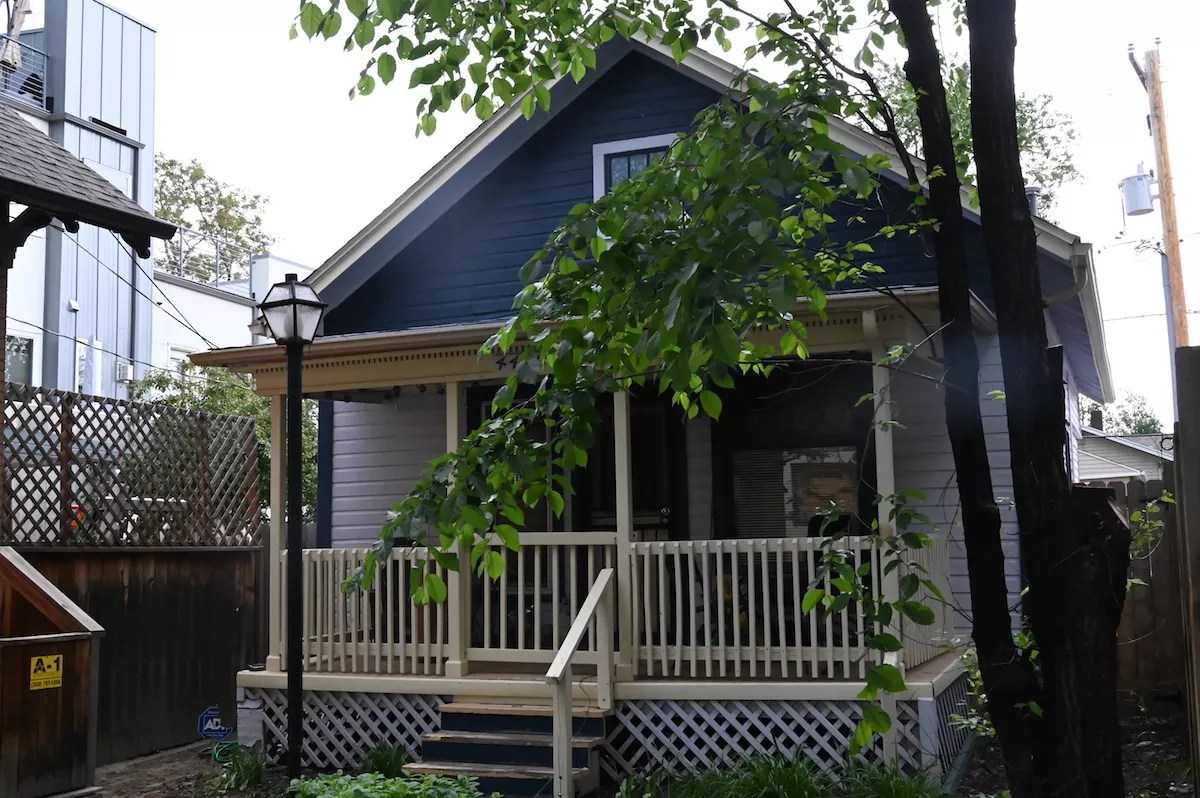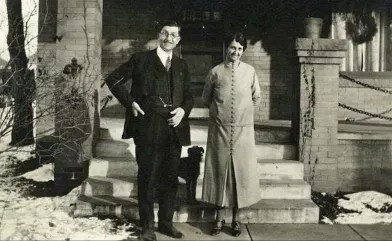
Bennito L. Kelty

Audio By Carbonatix
Just off Tennyson Street in northwest Denver, an old one-story house sits tucked in the shadow of sleek, modern apartment buildings. Daphne Salone, owner of the little home on 4450 Tennyson Street, likes to call it “Tenny” or “Little Tenny.”
“The house is adorable,” Salone says. “But regardless of what the house looks like, when you’re in it, whether you know the history or not, it’s powerful, what you feel in that little house.”
Salone is hoping for historic landmark status for the 115-year-old alley house in the Berkeley neighborhood. She’ll make her case to the Denver Landmark Preservation Commission on Tuesday, November 5, and share how Little Tenny encapsulates Denver’s history of affordable housing and immigration.
“It’s the perfect house to be designated as a landmark because of all that it represents,” Salone says. “Housing immigrants: Structurally, it’s a perfect example. Practically, it’s how the immigrants got here and got established.”
This year, make your gift count –
Invest in local news that matters.
Our work is funded by readers like you who make voluntary gifts because they value our work and want to see it continue. Make a contribution today to help us reach our $50,000 goal!
Salone started looking for help with the historic landmark designation process after a Westword article detailed her holdout house in 2023. She found Tom and Laurie Simmons, a husband and wife who run Front Range Research Associates, which specializes in historic preservation projects.
The Simmonses researched the property’s history and wrote the application submitted in April to the Denver Landmark Preservation Commission. They describe Little Tenny as a house that has supported immigrants looking for affordable housing to start their lives in Denver throughout the past century. The application lists the name of the property as “the Currie/Dryer Cottage,” named after its first two owners, and includes “Little Tenny” and “The Salone Cottage” as nicknames.
According to the preservation application, Tennyson Street became a vibrant hub for culture and commerce and the unofficial main street of northwest Denver in 1888, when the Denver & Berkeley Park Rapid Transit Company laid down tracks and opened a streetcar line. The streetcar ran up and down Tennyson Street between West 38th and West 41st avenues. At its south end, the streetcar took visitors to the old Elitch Gardens, which opened in 1890, for its zoo, theater and other attractions.
In 1892, some of the 450 residents in the area established the Town of North Denver, which was renamed Berkeley in 1898 to avoid confusion with the region of north Denver, according to the application. The name Berkeley came from Berkeley Farm, a 1,500-acre farm owned by John Brisbane Walker, who eventually left to edit Cosmopolitan magazine in New York. The farm occupied the land where Berkeley is today.
In 1901, Denver Tramway extended the streetcar line farther north to West 46th Avenue. That brought one of the stops for the Berkeley Park line past the plot where Little Tenny would later sit. In 1902, Denver annexed Berkeley, which was already one of the most diverse neighborhoods in the Denver region, with 10 percent of its population reported as immigrants, according to the preservation application; a small group of Black residents had also recently come to the area.

A photo from 1900-1905 looking north from 38th Avenue at Tennyson Street.
Denver Public Library/Western History Collection
Little House by the Alley
Little Tenny was built in 1909 by 44-year-old Andrew Wellington Currie, a Canadian immigrant and veteran carpenter in his forties. Currie had purchased two lots on Tennyson Street – one to build a large brick house for his family and another to craft a smaller, one-floor house made of brick and wood.
For a steady income on the side, Currie rented out the smaller house to Canadian, Bohemian, German, Swedish, Russian and Italian immigrants, who were often Catholic or Jewish at a time when the Denver region was mostly Protestant, according to the Simmonses, who describe Little Tenny as a “rare surviving example of the alley type of dwelling, which provided an early affordable housing option that served people priced out of home ownership.”
“It really is the most perfect example of how Denver attracted and welcomed immigrants,” Salone says. “And how immigrants populated our city and realized their dreams. They came, they bought a piece of property, and they were very forward-thinking.”
Currie decorated the interior of the house with ornamental moldings over the doorways, stained glass and an oval bullseye window in the parlor with smooth, carved wooden window frames and subtle flourishes. An old metal twist doorbell is still at the front entrance, along with Currie’s wooden lattice work around the bottom of the porch.
The preservation application describes the house as an alley house because it’s a small dwelling built between a larger house and an alley. Property owners in the early twentieth century built these kinds of houses throughout American cities because they didn’t take up much land, were easy to build and could be rented out for cheap to earn extra cash.
“The dwelling type was a form of less costly urban housing, often utilized by immigrants, African Americans, working-class people and young families,” reads the application. “Alley houses, the forerunners of today’s accessory dwelling units (ADUs), increased urban density near transportation routes, shops and business areas.”
Alley houses “supported the growth, diversity and prosperity of the area and created greater population density in the city’s historic close-in neighborhoods,” or neighborhoods close to the center of a metro area, the Simmonses note in the application. “The 115-year-old Currie/Dryer Cottage provides a tangible link to the early twentieth century history and culture of the Berkeley neighborhood in northwest Denver and to its historic ‘Main Street,’ Tennyson Street.”
Like that of most alley houses, Little Tenny’s roof is sloped on both sides. The foundation is made of brick, but the walls are clad in wood. A short porch with a lamppost nearby reaches out toward the mature honey locust and American elm trees growing behind a tiny, boxed garden.
The lush front lawn is one of the only patches of green on that concrete block of Tennyson. The house was built several yards back from the street, however, and closer to the alley behind it. Because the lawn stands out more prominently for those walking past it on Tennyson Street than the house itself, some neighbors confuse the grass as a small dog park, Salone says. The application describes the outside of the house as “unassuming” and “unpretentious.”
Immigrants Welcome

Joseph and Josephine Dryer, who came to Denver from Czechoslovakia, pose for this 1925 photo in front of the alley house they bought on Tennyson Street.
Courtesy of Front Range Research Associates
Currie lived in a larger brick house north of Little Tenny with his wife and their son while renting out the house for about $25 a month, according to the landmark application. Shortly after Currie’s wife, Mary, died in 1912, he sold both properties to Joseph and Josephine Dryer, who were Czechoslovakian immigrants, and moved to Southern California, where he lived until he died in 1965.
The Dryers owned the property for the next 79 years and made a point of renting it out to immigrants, widows, laborers, young families and seniors, historians note. The home’s most prominent tenant was Nathan Arenburg, a Jewish Russian immigrant who ran for the Colorado State Senate as a socialist while living at Little Tenny in 1918. Other tenants included an Italian baker in the ’30s, a British-American oil company employee in the ’50s and a Latina seamstress in the ’60s.
From 1920 to 1950, Denver dealt with a rise in anti-immigrant sentiment, and the Ku Klux Klan had a strong influence in Denver at the time. Benjamin Stapleton, a prominent KKK member, served as Denver’s mayor for twenty years during the period. Immigrants and non-Protestants became excluded from housing options across Denver, but on Tennyson Street, the Dryers never had a problem renting to them.
Houses like Little Tenny were “found throughout the Berkeley neighborhood,” according to the landmark application. That changed in the late twentieth century, when alley house owners across the country began demolishing the small houses out of fear that the outdated material and construction quality wouldn’t hold up much longer. Others converted their alley houses into garages, studios or shops.
In the 21st century, the pressure of new construction and development sped up the demise of alley houses, especially in Berkeley. In 1930, the neighborhood had about 25 alley houses, according to the Simmonses; today, Little Tenny and just three others remain. Currie “soundly constructed” the house more than a century ago, the couple adds, and it hasn’t had a problem standing the test of time.
In 2006, Salone bought the house for $185,000 to make it her accounting office. At the time, the area was “run down,” she recalls, “with a reputation of being somewhat unsafe.” Other historic homes and small shops on Tennyson Street were being demolished and replaced, mostly by three-story apartment complexes or commercial buildings.
At the time, Salone says, she was buying homes “like most girls buy shoes,” snapping up properties in Aurora and Sloan’s Lake as long-term investments. She kept Little Tenny as her accounting office until 2010, when she started renting it out to residential tenants. With a few exceptions, couples and singles would come and go every year, Salone says, until the current tenant moved in five years ago.

Today, the 115-year-old alley house on 4450 Tennyson Street sits in the shadows of three-story modern apartments.
Bennito L. Kelty
She didn’t realize the historical significance of Little Tenny until a few years ago, when a family stopped by to look around the home. They turned out to be Currie’s grandchildren, and after they told Salone of Little Tenny’s age, she discovered it was one of the oldest standing structures in Berkeley – even older than the Oriental Theater, which is on the National Register of Historic Places and was built a few blocks south in 1927. The home is also older than the brick former grocery store built across the street from the theater in 1923, which now houses Parisi Italian restaurant.
Berkeley currently has more than 9,000 residents. The neighborhood around Salone’s alley house “started transforming dramatically not long after I bought Tenny,” she says.
The public hearing to preserve Little Tenny will be on Tuesday, November 5, at 1 p.m. at the Wellington Webb Municipal Complex, 201 West Colfax Avenue. If the Landmark Preservation Commission approves the application for Little Tenny, Denver City Council would make the final decision in December, Salone says.
If Salone is successful, she plans to continue renting Little Tenny out: “Like the Dryer family before me,” she says, “I plan to continue to rent the house as a residence, not a business.”
The goal of landmark preservation is to preserve the physical integrity of a historically significant building, according to Denver Community Planning & Development. Having Little Tenny designated as a historic landmark means Salone won’t be able to make changes to the building unless she can convince the Landmark Preservation Commission it’s necessary. It also limits her ability to sell the property.
Salone says she is fine with that. She wants to share Little Tenny with Denver and make sure that it’s around for ages to remind people about the kind of place Denver was and continues to be, with immigration and housing still defining topics of the city.
“I’m fortunate that I’m able to not have to look at my house as an investment that I have to scrape someday to make some money,” Salone says. “The best value of this property is for it to be landmarked and preserved. That’s the best use for it for everybody in this city.”